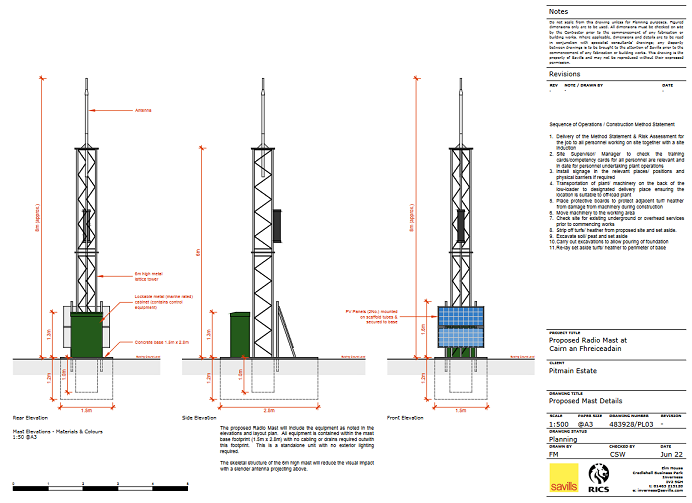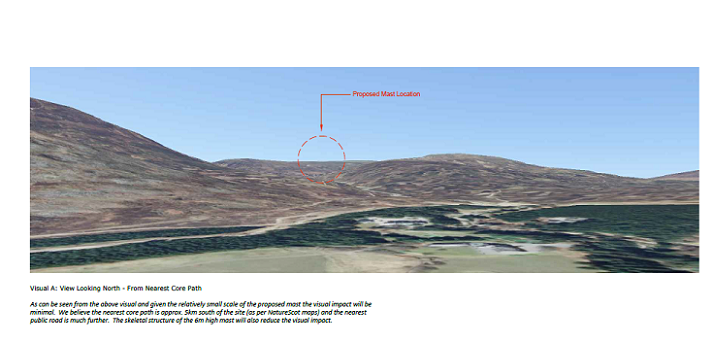[Post updated 22nd September].After the planning application to build a telecommunications mast on Carn an Fhreiceadain in the Monadhliath Wild Land Area was withdrawn for the second time, following a significant number of objections, I commented (see here) that it was impossible to know if Savills or the Pitmain Estate would come back again. Six months later they have (see here for planning documents). This post explains how the latest application addresses almost none of the issues raised by the original (see here) but raises new concerns.
The revised planning application
The application form reveals that on 16th February (two days after the Cairngorms National Park Adviser had submitted an extensive critique of the application) Savills were “Advised to withdraw application” by Highland Council. What that advice was is not stated. But instead of just three documents, as last time, Savills have now added a fourth which consists of a drawing of the proposed mast with a short Construction Method Statement:

The lack of any design details and a Construction Method Statement were two of the planning issues raised by the Cairngorms National Park Authority(CNPA)’s Landscape Adviser in their response to the last planning application. But the CNPA’s Landscape Adviser also recommended the developer should provide:
- “A description of the siting and design objectives for the proposed development to directly
respond to the specific landscape characteristics, visual amenity, wild land attributes and qualities, and SLQs [Special Landscape Qualities] within the CNP. - Leading from b above, information on alternative sites and designs considered and their relative benefits and disadvantages in terms of potential landscape and visual effects.
- A landscape and visual appraisal of the proposal, identifying the predicted effects on landscape character, visual amenity, wild land attributes and qualities and NP SLQs. It is advised that this should be informed by some visualisations of the proposed development from key routes within the NP including…………”:
Not only has Savill’s provided no such information in their latest application, they have removed the Landscape Visual Impact Assessments that accompanied the last one.

There is a good reason for that, the LVIA photomontages which were eventually supplied were hopeless. But the point is that Savills have still failed to respond to the concerns that were raised by the CNPA, a statutory consultee, last time around.
The documentation in the application is totally unfit for purpose and should never have been validated. As an indication of its quality in the application form Savills describe the Existing use as being “existing scrubland” – you won’t find any scrub on the overgrazed summit of Carn an Fhreiceadain.
Unfortunately, if you are a member of the public, you would be unlikely to appreciate any of this history because Highland Council has removed every single document relating to the previous application (see here). Wiping the public record clean is completely wrong and plays into the hands of developers.
The latest response of the Cairngorms National Park Authority
{This section was written on the basis of information available at the time. However, the CNPA have now confirmed that the letter referred to below not to call in the application was a mistake as it was not within the power of the CNPA to do so and that they have also submitted comments on the application as they did last time. You can read those comments here. This confirms the argument I made below, that whoever wrote that the application did not raise any planning issues of significance to the National Park was wrong to do so.]
While not yet on the Highland Council website, the CNPA’s own planning portal reveals it has responded to Highland Council (in an unsigned letter) stating that it does not intend to call-in the application (see here). This is not surprising as the development is just outwith its boundary and therefore outwith its jurisdiction. However, in justifying this decision the letter claims:
“the above planning application does not raise any planning issues of general significance to the park aims and as such No Call-in is necessary in this case.”
The response of the CNPA’s Landscape Adviser to the last application – luckily I downloaded a copy (see here) at the time – completely contradicts this:
“The predicted landscape and visual effects of the proposed development summarised above would affect the National Park SLQs including the: ‘vastness of space, scale and height’; a ‘landscape of layers’; ‘dominance of natural landforms’; ‘layers of receding ridge lines’; ‘wildness’; and ‘wild land’.”
It is impossible to reconcile these two statements and in my view the CNPA has some explaining to do but it is not too late for them to submit a formal response to the application based on what they said last time. That would be consistent with statements CNPA officers made to their Planning Committee in April (see here)about how the proposed Lethen Windfarm would impact on the landscape qualities of the National Park;
“The proposed wind farm would be located within (and significantly affect) the rounded hills outside of the National Park. There is a strong connection between this and the adjacent Landscape Character Type inside the National Park, where they share some key characteristics, such as a sense of remoteness, underpinning the Wildness SLQ. Visibility from within the National Park would be limited to the ridgeline that demarcates both the National Park boundary (and the less obvious on the ground
change in character type). The expression of the Wildness SLQ is high on and along this ridgeline especially where it draws on the characteristics that continue beyond the National Park boundary”
A summary of what is wrong with the telecommunications mast planning application
In the original application the justification for the application was that it was needed for health and safety reason after a member of staff was stranded in their vehicle. The new application continues to refer to that incident as “recent” and makes no attempt to explain why estate staff could not be issued with satellite phones. The site layout plan does, however, include what appears to be a new statement (I did not keep a copy of the original):
“This [ie the development] will also facilitate communication for sporting use of the surrounding land within the estate”.
This confirms the argument I made in my first post, that the real reason for this development is that shooters can continue to use their mobile phones while out on the hill. Unfortunately, under Scotland’s Planning system, the fact that a development may be unnecessary is not in itself a reason for rejecting it.
There are, however, very good planning reasons for Highland Council to reject the application:
- The proposal is not supported by the policies in Highland Council’s Local Development Plan, more particularly their policies on communications masts as pointed out by Mountaineering Scotland in their response to the application (see here)
- There is no assessment of the impact that the telecommunications mast will have on the Wild Land Area or the landscape, including the National Park, and this will be significant.
So far, only two objections to the application has been published on Highland Council’s Planning portal. It is a fundamental failing of Scotland’s planning system that when developers submit slightly revised planning applications that previous comments from organisations and the public are not automatically reconsidered by Planning Authorities and previous objectors are not even alerted to the new application. It enables developers to game the system. You can help stop Pitmain and their agents, Savills, getting away with this by lodging an objection here.

Make that 3 objections – thanks for the heads-up
Another objection duly logged!